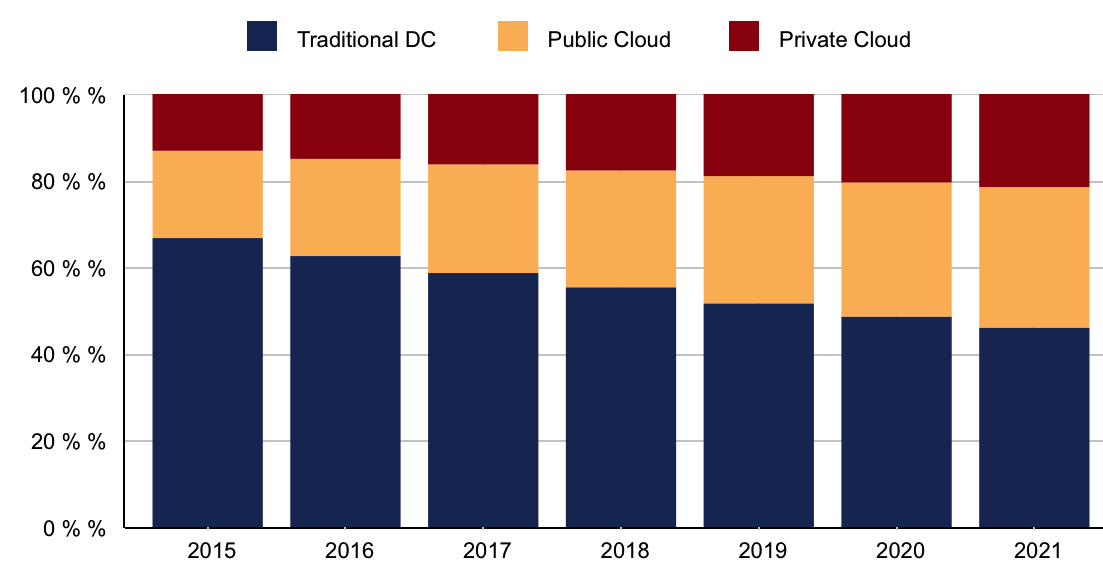WW Spending on IT Infrastructure (Server, Enterprise Storage and Ethernet Switches) for Deployment in Cloud Environments Up 12.4% Y/Y in 2017 to $40 Billion – IDC
Fastest growing among IT deployment segments this year
This is a Press Release edited by StorageNewsletter.com on July 6, 2017 at 2:24 pmAccording to a forecast from the International Data Corporation‘s Worldwide Quarterly Cloud IT Infrastructure Tracker, total spending on IT infrastructure products (server, enterprise storage, and Ethernet switches) for deployment in cloud environments will increase 12.4% year over year in 2017 to $40.1 billion.
Public cloud datacenters will account for the majority of this spending (60.7%) and will grow at the fastest rate year over year (13.8%). Off-premises private cloud environments will represent 14.9% of overall spending and will grow 11.9% year over year. On-premises private clouds will account for 62.2% of spending on private cloud IT infrastructure and will grow 9.6% Y/Y in 2017.
Increased spending on cloud IT infrastructure and decreasing investments in non-cloud IT infrastructure will be a common theme for all regions. Worldwide spending on traditional, non-cloud, IT infrastructure will decline 4.6% in 2017 accounting for 58.7% of the overall end-user spending on IT infrastructure products across the three segments, down from 62.6% in 2016.
Note: All figures above exclude double counting between server and storage.
In cloud IT environments, Ethernet switches will be the fastest growing technology segment with 25.8% year-over-year growth in 2017, while spending on servers and enterprise storage will grow 9.1% and 12.0%, respectively. These growth rates include double counting between server and storage to represent each of the technology segments. In all three technology segments, spending on IT infrastructure deployed off-premises will grow in 2017 while spending on on-premises environments will decline.
Over the five-year forecast, IDC expects spending on off-premises cloud IT infrastructure will have a CAGR of 11.0%, reaching $45.7 billion in 2021. Public cloud datacenters will account for 79.8% of this amount with an 11.0% CAGR, while spending on off-premises private cloud infrastructure will increase at an 11.3% CAGR. Combined with on-premises private cloud, overall spending on cloud IT infrastructure will have a five-year CAGR of 10.9% and by 2020 will surpass spending on non-cloud IT infrastructure. Spending on on-premises private cloud IT infrastructure will grow at a 10.5% CAGR, while spending on non-cloud IT (on-premises and off-premises combined) will decline at a 3.1% CAGR during the same period.
WW Cloud IT Infrastructure Market Forecast by Deployment Type 2015 – 2021
(shares based on Value)

(Source : IDC Worldwide Quarterly Cloud IT Infrastructure Tracker, Q1 2017)
“The overall profile of spending on IT infrastructure in various deployment/location scenarios seen in 2016 will continue in 2017 with some differences in specific technology segments,” said Natalya Yezhkova, research director, enterprise storage. “Enterprise adoption of hybrid and multi-cloud IT strategies and the proliferation of cloud-native applications and areas such as IoT, which embrace a cloud-first approach to supporting IT resources, will fuel further increases in end-user spending on services-based IT. In turn, this move will be reflected in a shift of the overall spending on IT infrastructure from on-premises to off-premises deployments and from traditional IT to cloud IT.”
Taxonomy notes:
IDC defines cloud services more formally through a checklist of key attributes that an offering must manifest to end users of the service. Public cloud services are shared among unrelated enterprises and consumers; open to a largely unrestricted universe of potential users; and designed for a market, not a single enterprise. The public cloud market includes variety of services designed to extend or, in some cases, replace IT infrastructure deployed in corporate datacenters. It also includes content services delivered by a group of suppliers IDC calls Value Added Content Providers (VACP). Private cloud services are shared within a single enterprise or an extended enterprise with restrictions on access and level of resource dedication and defined/controlled by the enterprise (and beyond the control available in public cloud offerings); can be onsite or offsite; and can be managed by a third-party or in-house staff. In private cloud that is managed by in-house staff, ‘vendors (cloud service providers)’ are equivalent to the IT departments/shared service departments within enterprises/groups. In this utilization model, where standardized services are jointly used within the enterprise/group, business departments, offices, and employees are the ‘service users.’
Read also:
Worldwide Cloud IT Infrastructure Revenue Up 15% to $8 Billion in 1Q17 – IDC
Top three are Dell, HPE and Cisco.
This is a Press Release edited by StorageNewsletter.com on 2017.07.05












 Subscribe to our free daily newsletter
Subscribe to our free daily newsletter
